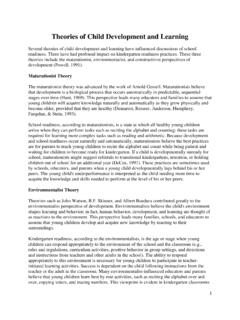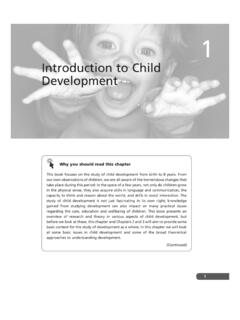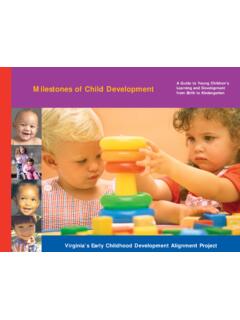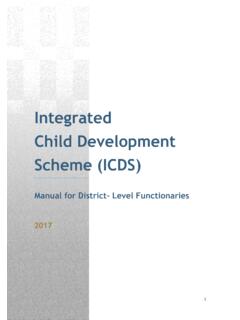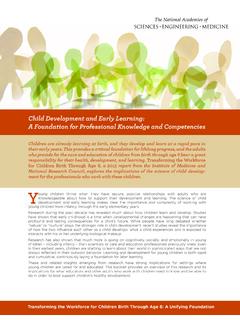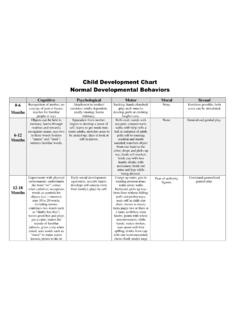Transcription of Module 1: Principles of Child Growth and Development
1 1 Child Growth and DevelopmentModule 1: Principles of Child Growth and DevelopmentChild Growth and Development2 IconsThis icon represents a new topic in the text. This is a visual cue for you to answer any questions about the previous section before moving along to the next icon is used to identify an exercise that involves in-class practice and icon is used to identify a specially designed activity that requires active class icon is used to identify a section that is accompanied by a Growth and Development3 IconsThis icon is used to identify a section where the participants should add items to their Do s and Don ts icon is used to identify an exercise that involves a role-playing icon is used to identify the use of a transparency related to the material in this icon is used to identify a key point in the Growth and Development4 Growth often hear people refer to children s Growth and Development .
2 Are Growth and Development the same thing? What does each of these terms mean? Growth refers to specific body changes and increases in the Child s size (such as:height, weight, head circumference, and body mass index). These size changes can easily be measured. Development typically refers to an increase in complexity (a change from simple to more complex) Involves a progression along a continuing pathway on which the Child aquires more refined knowledge, behavior, and skills. The sequence is basically the same for all children, however the rate Growth and Development5 Growth ( )We defined Growth as specific bodychanges and increases in the Child s size. During the first year of an infant s life, babies can grow 10inches in length and triple their birth weight. After the first year, a baby s Growth in length slows to 5inches a year for the next two years and continues from age two or three to puberty at a rate of two to three inches each year.
3 A major Growth spurt occurs at the time of puberty. Girls generally enter puberty between ages 8to 13years of age. Boys usually enter puberty at ages 10to 15years of Growth and Development6 Similarities in Growth ( ) Growth proceeds from the headdownward and from the center of the bodyoutward. Children gain control of the head and neck first, then the arms and finally the legs. At birth, the brain, heart, and spinal cord are fullyfunctioning to support the infant. As children grow, the armand legmuscles develop followed by the finger and toe Growth and Development7 Differences in Growth Children differin their Growth . Some children are taller, some shorter. Some children are smaller, while others are larger. These differences are completely normal. Normal Growth is supported by good nutrition, adequate sleep, and regular exercise. Children do not grow at perfectly steady rates throughout childhood.
4 Children will experience weeks or months of slightly slower Growth followed by Growth spurts. Difference in the amount of Growth can be a source of self-consciousness for some children. It is important to help the children in your care understand that these differences are normal, that each Child is special, and to help children develop a sense of Growth and Development8 Principles of Growth How can you help children understand their differences in Growth ?Show pictures of various stages of Growth in Growth and Development9 Principles of Growth If you detect that a Child is self-conscious about her size, how would you help her work on increasing her self acceptance?Either individually or in a group, talk about how things are different but equally important and : Litter of puppies or kittens-different in size and color but they are all special and will grow into wonderful dogs and catsChild Growth and Development10 Principles of Growth If you have some concern about a Growth related issues about a Child , how would you approach this issue with the parent(s)?
5 Share information and typical Growth patterns with parents. Ask the parents if they have questions. Do they have interactions with a doctor, if not suggest local Growth and Development11 Key PointGrowth is defined as specific body changes and increases in the Child s size. Growth proceeds from the head downward and from the center of the body outward. Children differ in their Growth and Development12 Key PointDevelopment typically refers to an increase in complexity, a change from relatively simple to more complicated. Development usually involves a progression along a continuous sequential pathway on which the Child acquires more refined knowledge, behaviors, and skills. The sequence is basically the same for all children; however, the rate Growth and Development13 Principles of Child Sequence is Similar for Proceeds from General to is Proceeds at Different Areas of Development are InterrelatedChild Growth and Development14 Key Point are certain periods of time when children are especially receptive to their surroundings and interactions with other people.
6 These periods of time are tied to brain Development and readiness for learning. Both will directly affect the achievement of developmental Growth and Development15 Experiences and Environmental Influences that Impact Brain Development ( )Everything you do in the Child care setting has an effect on the Child s Development and learning. How you diaper, feed, and put to sleep; The way you greet, and the way you comfort; The amount of spacethe Child has to play in, and the ambient lighting; The songs you sing; The toys you provide; The meals you serve; These things and more all have an effect on the Development of a Child s brain and their ability to socialize and Growth and Development16 Implications for Learning should Child care professionals learn about Principles of Child Development ? and the environment can support or hinder knowledgeable caregiver can support a Child in learning new a Child is struggling with a new skill, timely intervention can help him overcome a problem and catch back up.
7 Knowledgeable caregiver can detect indicators of possible delays, and can help get the Child the assistance he Growth and Development17 Key PointAll of your interactions with a Child have an effect on the Child s Development and learning. It is important to be aware of what the Child is learning while in your Growth and Development18 Implications for Learning As a Child care provider you should always be on the lookout for signs of developmental delays and be aware of appropriate methods of dealing with children experiencing developmental delays. You may use the knowledge about the Principles of Child Growth and Development to spot the Child who is not yet showing the skills and behaviors we would expect in a certain age range. Certain aspects of Development may be slowedor non-existent, depending on the Child . Just because a Child may be developmentally delayedin an area, it is important to continue to help the Child develop as much as possible in the area in which he is delayed.
8 Developmentally appropriate practices for this Child may differ from those expected for the Child s age. Include the Child in all activities in which he can safelyparticipate. Increased supervision or attention may be required to ensure safety and well-being. Such a Child may also be in need of professional help such as speech therapy, vision correction, physicaltherapy or hearing aids. It is important to remember that you should NOT diagnose children. If you have any concerns regarding the Growth and Development of a Child , the concerns should be presented to the appropriate Growth and Development19 Key PointThe skills and behaviors generally typical for children at a certain age range may not be possible for some children who are developmentally Growth and Development20 Implications for Learning Now let s talk about the Americans with Disabilities Act.
9 Passage of the Americans with Disabilities Act (ADA) in 1990 sent a clear message to the American people that children and adults with disabilities are entitled to the same rightsand privileges that others enjoy. This means that children with disabilities are legally entitled to equal accessto community-based Child care settings. However, a legal mandate by itself is not sufficient to make available realistic and responsive Child care options for children with disabilities. Although the picture is improving, families continue to have difficulty finding inclusive Child care programs for their Growth and Development21 Activity A Child who is physically-challenged (a Child wearing a leg brace)Ensure learning centers have ample space for movement A Child who is socially-challenged (a Child who has autism)Reduce number of transitions throughout the day A Child who is shy or emotionally challengedEnsure the environment feels safe for the Child A Child who is giftedProvide activities that are slightly challenging to the Child A Child who is mentally-challengedProvide activities to increase Development without causing frustrationChild Growth and Development22 Key PointChildren with disabilities are legally entitled to equal access to community-based Child care Growth and Development23 Key PointChild care professionals may spot developmental issues before the parents do.
10 This is why it is important to understand the basic Child Growth and Development Growth and DevelopmentModule 2: Child Development TheoriesChild Growth and Development25 What is a theory? ( )A theory is a set of facts or Principles analyzed in relation to one another and used to explain phenomena (a fact or behavior that can be observed). Child Growth and Development26 Maslow and the Hierarchy of Needs ( ) Maslow developed a hierarchy of humanneeds. In a hierarchy, one set of things is dependent on the next, both of which are dependent on the next, and so on. Maslow s hierarchy has fivelevels, is pictured as a pyramid and goes from bottom (human need number 1) to top (human need number 5). Like a pyramid, it builds one level upon the level below. Satisfying the needs on the second level depend on the firstlevel needs being satisfied and ready to be built Growth and Development27 Hierarchy of Needs Growth and Development28 Maslow and the Hierarchy of Needs ( )Level 1: Examples Rest, sleep Food, water, formula Shelter, heat, beds Health care Transportation Employment or incomeChild Growth and Development29 Maslow and the Hierarchy of Needs ( )Level 2: Examples Transportation Housing Neighborhood Safe relationships Child careChild Growth and Development30 Maslow and the Hierarchy of Needs ( )Level 3: Examples Sense of belonging (connected) Adult-adult affiliation Parent- Child relationship Positive relationships with extended family Positive formal and informal social support networkChild Growth and Development31 Maslow and the Hierarchy of Needs ( )Level 4.








